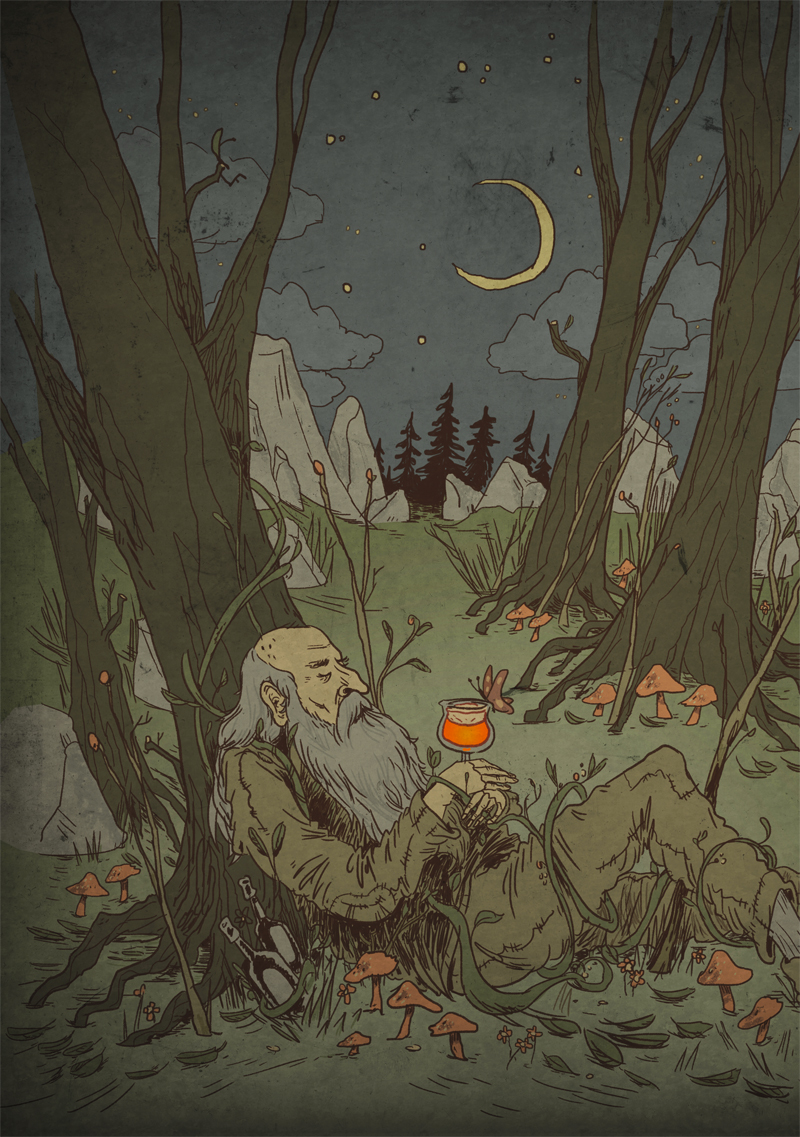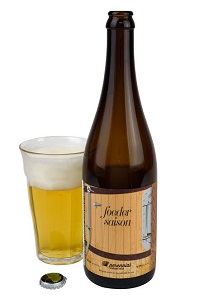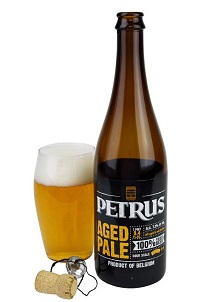Slow Beer: The History of Aging Beer

(Illustration by Brendan Leach)
Barrel-aging may be all the rage at the moment, but giving beer time to mature is nothing new. And it wasn’t done by halves. While a modern lager might spend a few weeks aging and a barrel-aged beer sits a couple of years in wood, in the past, beers could mature for decades.
Stock Ale and Mild Ale
First a little explanation of old brewing terminology is in order. In the 18th and 19th centuries, ale was conditioned in two ways. It could be sold either “mild”—that is, young—usually no more than a week or two after being racked into barrels, or “stock,” aged for months or even years before sale.
Aging wasn’t limited to commercial breweries. Until the middle of the 19th century, much of the beer in the U.K. was produced by “domestic” brewers: that is, brewed in a residence for the use of the family, servants and staff. Unburdened by commercial considerations, the household brewer could afford to let beer mature for what appears today a ridiculous length of time.
A brewer giving evidence before a Parliamentary committee in 1899 identified four classes of commercially brewed beer (see table).
Table: Classes of Commercially Brewed Beer in 1899
| Type | English malt (%) | Foreign malt (%) | Sugar (%) | Time aged before delivery |
|---|---|---|---|---|
| Stock Ale | 66 | 25 - 34 | 0 - 9 | 4 to 12 months |
| Semi-Stock Bottling Beers | 60 | 25 | 15 | 3 months |
| Light Pale Ales | 55 | 25 | 20 | 2 to 4 weeks |
| Mild Ale | 50 | 25 | 25 | 4 to 10 days |
The witness, though, acknowledged that enthusiasm for stock ales was waning.
“The taste for fresh ales as against stock ales set in some 20 years or more ago,” the brewer said, according to minutes of evidence taken before the committee, “and it has been steadily progressive without any tendency to reversion; and even within the past few years I have known brewers who previously brewed their pale ales on stock principles abandon stock beer brewing, and have found that the ales brewed on running ale lines have given greater satisfaction.”
A few long-aged beers did struggle on into the 20th century, maintaining an ancient tradition. Over the centuries many types of long-aged beer were produced in Britain, both privately and commercially. Here are a few examples.
March Beer/October Beer
Before 1850, when all country households of any importance still brewed their own beer, the local gentry were extremely proud of their special October beer. Throughout the year, household brewers made mild ales, drunk fresh, for day-to-day use. But once or twice a year, they made something stronger, a beer reserved for special occasions and honored guests.
These strong beers were mostly made when the ambient temperature was best for brewing: either March or October. Hence the names March beer and October beer. Many preferred October on account of the several months of cold weather that followed.
The theory behind brewing in October went like this: At the time of brewing, the temperature would be perfect for the initial fermentation. As the weather became colder, the fermentation would slow and eventually stop. When the warmer spring weather arrived, it woke up the yeast and a second fermentation began to complete the job. But the beer still wasn’t ready to be drunk. It was left until at least September before being tapped. A longer wait was recommended for those who could keep their patience.
Without the monetary constraints of commercial brewers, domestic brewers could afford to leave their beer to mature for years. Some wouldn’t touch their October beer at less than three years old. Others boasted of beer kept five or even 10 years, so strong that it could only safely be consumed by the wine glass.
Stock Pale Ale
Today’s drinkers want their IPA as fresh as possible, preferably grabbed directly from the bottling or kegging line and consumed on the spot. Victorian Brits had different expectations. The discerning IPA drinker wanted a properly matured beer, something like Bass.
Bass’ method of maturing pale ale sounds utterly, utterly crazy, but confirmed by several independent sources. It received no careful curation in a cool cellar. After being racked into casks, it was piled up in the brewery yard, open to the elements, with only a little wetted straw in the warmest weather as protection. After a year of this brutal treatment, it was deemed ready to be shipped to India, toughened enough during its time in the yard to survive the long trip and helped by Brettanomyces, which stripped everything fermentable that an infection might feed on.
When East India Company officials and army officers got their hands on a bottle of Bass, the beer inside was 18 months old. Drinkers back in Britain had to make do with a version six months younger.
Russian Stout
Originally brewed for Catherine the Great’s court, Russian stout was always given time to mature properly. During the 19th century, aging a strong stout for a year or two wouldn’t have been out of the ordinary. Even in the 1930s, the Barclay Perkins advertisements still boasted a minimum of two years’ aging in wooden vats, at a time when such long aging had become a real rarity.
Russian stout’s secondary conditioning with Brettanomyces couldn’t be rushed. The wild yeast slowly chewed its way through the less-fermentable sugars, dropping the racking gravity of 1.034 to a final gravity of 1.024 and, in the process, boosting the ABV from 9% to 10.5%.
Aging didn’t end with bottling. With live Brettanomyces still present, Russian stout had excellent protection against oxidation, not just surviving, but improving over decades. I drank a bottle that was over 25 years old and still in excellent shape.
Majority Ale
The heir coming of age was an opportunity for a landowner to show off by entertaining hundreds, or even thousands, of guests. Oxen and sheep would be slaughtered and roasted for the poor, while the higher orders would feast magnificently in the main house.
Beer was central to the celebrations. But not just any beer. At the heir’s birth, a special strong brew was made in the country house’s brew house, using large quantities of the very best ingredients. It was then laid down in a cellar and forgotten, to be drunk when the heir turned 21. Now there’s patience.
Guests appreciated the time and effort spent brewing this very special beer.
“… the poor of the neighbourhood, upwards of 4,000 in number, were liberally entertained with old English fare, under an extensive and splendid marquee in the park,” according to an 1839 edition of the Staffordshire Advertiser. “There was an abundant supply of ‘nut brown ale’— some famous stuff, which many of the partakers declared was far preferable to champagne.”
Majority ale was usually brewed domestically. Surprisingly, though, the tradition was practiced at one large Edinburgh brewer, William Younger, even continuing into the 20th century. In this case it wasn’t just a privilege reserved for the Younger family heir, but rather for all members of the family. At every birth a miniature brew of majority ale was produced in the brewery and carefully stored to be drunk 21 years later.
Sadly, aging beer fell out of fashion toward the end of the 1800s, with just a handful of beers like Russian stout clinging on. Only in the past 20 years has a new generation of brewers rediscovered the delights a patiently matured beer can offer and revived a centuries-old tradition.
Long-Aged Oak Beers
Spending four months or more in wooden foeders.
The following beers were reviewed by our beer editor, Ken Weaver.

Perennial Foeder Saison
ABV: 5% | Oak-Fermented Belgian-Style AleTasting Notes: This saison was fermented in oak withBrettanomyces, Lactobacillus and Pediococcus, and the result’s actually quite similar in scope to a lambic/saison blend. There are warming touches of spicy oak on the periphery, while a tempered, complex acidity gives this saison a lemony, berry-tinged lift. The carbonation’s just enough, and the oak exposure and complex ferment afford plenty of different spaces to get lost in.

Petrus Aged Pale
ABV: 7.3% | 100% Oak-Fermented Pale AleTasting Notes: Relative to the Perennial, this takes on a significant element of oxidation from the 24 months it spent aged in oak barrels. But the feeling’s anything but stale, instead introducing the subtle nudge of caramel alongside layered and complex tartness. One catches hints of brine, deep notes of grapefruit pith and zest, and mouthwatering lemon-focused acidity throughout that’s always assertive, never sharp. Delicious, nuanced beer that you just can’t make quickly.
Ron Pattinson
Ron Pattinson is a British beer writer and historian who lives in Amsterdam.

Were regular IPA and RIS matured with brett yeast?, this is not teached on regular beer books.
The Brett was a naturally occuring wild yeast in barrels and the environment. It was not pitched on purpose but was part of the natural “yeast cocktail” traditionally used.
Brett was first identified in old English beers and Brett means British in latin.